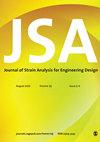带圆腔的形状记忆合金板的应力集中:相变、饱和和塑性的影响
IF 1.4
4区 工程技术
Q3 ENGINEERING, MECHANICAL
Journal of Strain Analysis for Engineering Design
Pub Date : 2022-07-26
DOI:10.1177/03093247221113755
引用次数: 0
摘要
几何非均质智能结构的应力集中分析具有重要意义。本文利用一种考虑形状记忆合金相变和塑性的新本构模型,研究了圆形空腔板的应力集中系数(SCF),以及可能发生的局部相变、饱和和塑性的影响。结果表明,奥氏体相向马氏体相的转变导致SCF的降低。应力集中点相变饱和后,SCF增大,直至整个薄片进入马氏体相。在所研究的算例中,SCF达到5.8,大大高于弹性SCF。通过进入局部塑性区,SCF减小。此外,还对具有多个空腔的薄板进行了建模。结果表明,与单纯的弹性应力集中研究相比,额外孔作为一种应力消除方法对降低形状记忆合金的最大应力集中(考虑相变和塑性)具有更强的作用。本文章由计算机程序翻译,如有差异,请以英文原文为准。
Stress concentration in shape memory alloy sheets with circular cavities: Effects of transformation, saturation, and plasticity
The analysis of stress concentration in geometrically heterogeneous smart structures is of great importance. In this study, by utilizing a recent constitutive model which considered both transformation and plasticity of shape memory alloys (SMAs), the stress concentration factor (SCF) in plates with circular cavities is investigated and the effect of phase transformation, saturation, and plasticity which may occur locally is studied. The results show that the conversion of the austenitic phase to the martensite leads to a reduction in SCF. After saturation of phase transformation at the stress concentration point, the SCF increases until the entire sheet enters the martensite phase. In the example under study, the SCF reaches 5.8 which is greatly higher than the elastic SCF. By entering the plastic region locally, the SCF reduces. Also, the modeling of sheets with more than one cavity has been done. It is concluded that extra hole, as a stress relief method, has a stronger effect on decreasing maximum stress concentration of shape memory alloys (considering transformation and plasticity) compared to purely elastic stress concentration studies.
求助全文
通过发布文献求助,成功后即可免费获取论文全文。
去求助
来源期刊

Journal of Strain Analysis for Engineering Design
工程技术-材料科学:表征与测试
CiteScore
3.50
自引率
6.20%
发文量
25
审稿时长
>12 weeks
期刊介绍:
The Journal of Strain Analysis for Engineering Design provides a forum for work relating to the measurement and analysis of strain that is appropriate to engineering design and practice.
"Since launching in 1965, The Journal of Strain Analysis has been a collegiate effort, dedicated to providing exemplary service to our authors. We welcome contributions related to analytical, experimental, and numerical techniques for the analysis and/or measurement of stress and/or strain, or studies of relevant material properties and failure modes. Our international Editorial Board contains experts in all of these fields and is keen to encourage papers on novel techniques and innovative applications." Professor Eann Patterson - University of Liverpool, UK
This journal is a member of the Committee on Publication Ethics (COPE).
 求助内容:
求助内容: 应助结果提醒方式:
应助结果提醒方式:


